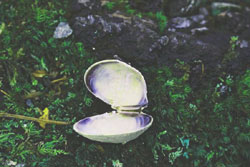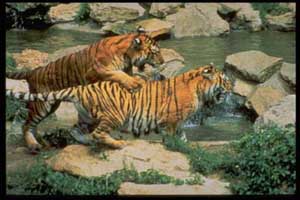| Environment Young Dreams
|
|||||
I could barely hear myself think. The room reverberated to the sound of 250 throats imitating tigers. This was followed by calls that only the children recognised as belonging to the world of elephants. Their teachers were in shock, but we had worked out a signal before hand. A whistle, loud and shrill from two fingers popped into my mouth was all it took to convert this explosive throng to pin-drop silence. It was a game I played with the kids that I probably enjoyed more than they did. I try to speak to at least five or six thousand children every year. This is my way of keeping both my sanity and my optimism intact. I was in the process of taking a batch of Cub Club members though their natural history paces by way of an illustrated jaunt through the most remote parts of our exquisite country. We spoke of tigers and lions and cockroaches. Who loves tigers? How do elephants communicate? The whistle blew before they could bring their school down. And then I asked, "And who loves cockroaches?" |
Environment • Beautiful Beasts • Paradise in the Wild • The Ocean:Conquest • A Source of Solace • Sighting the Ocean • The Ocean in Verse • Childhood Dream • Hunt for Indian Tiger
Adventure activities | ||||
To the accompaniment of scrunched noses and exaggerated disgust the kids rejected the very notion. Which took me neatly on to the next lesson. Every animal has a purpose, I told them. If the cockroach did not eat the waste matter you leave around in your homes then bacterial infections would probably cause you to fall sick almost every single day. The cockroach is a scavenger just the same as the hyaena, or the vulture. They learn fast, kids do. I doubt they would go so far as to say they love cockroaches, but I would wager that they would be able to provide their parents with sound reasons for using cleanliness rather than poison as the strike strategy for pest control. In a few short weeks National Wildlife Week will be upon us. This is when I exhort children to take the message of environmental protection home, to their parents. Sometimes I wonder if it is right on my part to use children so blatantly to infiltrate their families. I know of hundreds of mothers, for instance, who have changed the very way they think because their children introduced them to new ideas, new ways to view the earth. This is one very good reason why no amount of time invested in the young is ever wasted. How I wish these bright and innocent little humans were the focus of our national development! Our elected leaders invariably claim they do what they do to leave a legacy for the next generation. And, as if to prove the point, on National Wildlife Week you can be sure that scores of photographs of ministers planting trees will pollute our newspapers. When I am with children it takes every ounce of restraint for me to desist from telling them the horrible truth about our generation and its hypocrisy. Instead, I focus on the beauty and wonder and sheer joy of nature even as I continue to batter my generation at different fora by exposing their hypocrisy at every opportunity.
I must be blessed. Children trust me. I therefore try and sketch for them a canvass that reveals a land blessed by productive coastlines, an equitable climate, fertile soils and rain-fed rivers. But I somewhat reluctantly do let them know that my generation is mismanaging these natural gifts and that this is the reason for more frequent and more violent floods, landslides, cyclones and droughts. But, I quickly add: Nature is a self-repairing machine. All it asks of us is that we use it, rather than abuse it. Protecting nature I tell them is not a luxury, but a vital national imperative. And I remind them that wild animals like the elephant and tiger require to be protected not merely for their aesthetic or cultural worth.. Without them, and the myriad creatures that share their space, we will lose the green armour on which the health of the Indian subcontinent and its people is directly dependent. I worked for over two decades to convince my generation of just such facts but made very slow headway. Now I use children to teach those who should know better and I find the pace quickening. The elder generation it would seem can still be moved by young dreams.
Courtesy: Sanctuary Magazine
|
|||||
Editor: Romola Butalia (c) India Travelogue. All rights reserved. |
|||||


 Wildlife Week is a great time of year for those who flow with the tide of young enthusiasm. Literally thousands of young children will now bask in the excitement of demonstrating their love for animals and for nature. The tiger and the elephant are great favourites and almost invariably land up in the art works that kids use to decorate their schools during Wildlife Week. But increasingly I find images of lesser-known creatures emerging from the crystal imagination of young minds. When I last judged a painting contest for school children in Bombay some months ago, for instance, over a dozen or so out of the nearly 80 entries I saw had recognisable images of creatures such as hornbills, spiders and crocodiles. Their visuals also told of flowing streams and verdant forests. What I love about young persons is their ability to make gigantic leaps of the imagination to encompass things they have never seen provided they hear about them from people they trust.
Wildlife Week is a great time of year for those who flow with the tide of young enthusiasm. Literally thousands of young children will now bask in the excitement of demonstrating their love for animals and for nature. The tiger and the elephant are great favourites and almost invariably land up in the art works that kids use to decorate their schools during Wildlife Week. But increasingly I find images of lesser-known creatures emerging from the crystal imagination of young minds. When I last judged a painting contest for school children in Bombay some months ago, for instance, over a dozen or so out of the nearly 80 entries I saw had recognisable images of creatures such as hornbills, spiders and crocodiles. Their visuals also told of flowing streams and verdant forests. What I love about young persons is their ability to make gigantic leaps of the imagination to encompass things they have never seen provided they hear about them from people they trust.